A PINEDALE ANTICLINE PHOTOJOURNAL--Part I: The Grouse
As a follow-up to my earlier post on the politics of energy extraction and conservation on Wyoming's Pinedale Anticline, I offer this report from a recent visit to the region with my friend, Steve Chindgren, who probably understands Sage Grouse (Centrocercus urophasianus) better than anyone.
With an average 60 frost-free days per year, spring comes late to the Anticline, but it is has most certainly arrived. This week midday temperatures soared up near 80ºF. The spectacular lekking displays of cock Sage Grouse are little more than a memory. May 16, 7:00am: A month ago more than 200 cocks displayed on this lek. Now, just a handful of desperate birds loiter unenthusiastically after having strutted the previous night away. Strutting hours are strictly enforced by the grouse's chief predator, the Golden Eagle (Aquila chrysaetos), which doesn't begin hunting until the sun has warmed it. When the moon is full, the grouse take full advantage of eagle-free hours, and display through the night. All of the self-respecting hens are nesting now, and only ones that have already lost their eggs will visit the leks this late, trying for a second shot. At the peak of the season, fertilization of the hens is done by a tiny minority of cocks. Whether these late lekkers represent alpha birds or some other demographic has yet to be established.
May 16, 7:00am: A month ago more than 200 cocks displayed on this lek. Now, just a handful of desperate birds loiter unenthusiastically after having strutted the previous night away. Strutting hours are strictly enforced by the grouse's chief predator, the Golden Eagle (Aquila chrysaetos), which doesn't begin hunting until the sun has warmed it. When the moon is full, the grouse take full advantage of eagle-free hours, and display through the night. All of the self-respecting hens are nesting now, and only ones that have already lost their eggs will visit the leks this late, trying for a second shot. At the peak of the season, fertilization of the hens is done by a tiny minority of cocks. Whether these late lekkers represent alpha birds or some other demographic has yet to be established.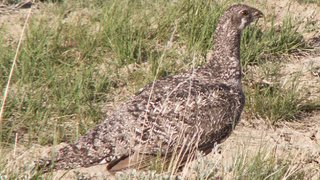 This lone hen has probably just lost her clutch of eggs. Soon she will group up with other lone females to visit what small leks are still active, then attempt a second nesting. Sage Grouse are very social birds, and they winter in huge mixed flocks. As the strutting season begins in February, the sexes segregate. Once bred, the hens beome solitary for the nesting season. Through the summer they will lead their chicks through good foraging areas, and in the fall the birds will regroup to head for the wintering grounds. Ravens (Corvus corax) are presumed to be the most important grouse egg predators, but practically nothing is known of the causes of nesting failure, since Sage Grouse nests are so incredibly hard to locate.
This lone hen has probably just lost her clutch of eggs. Soon she will group up with other lone females to visit what small leks are still active, then attempt a second nesting. Sage Grouse are very social birds, and they winter in huge mixed flocks. As the strutting season begins in February, the sexes segregate. Once bred, the hens beome solitary for the nesting season. Through the summer they will lead their chicks through good foraging areas, and in the fall the birds will regroup to head for the wintering grounds. Ravens (Corvus corax) are presumed to be the most important grouse egg predators, but practically nothing is known of the causes of nesting failure, since Sage Grouse nests are so incredibly hard to locate.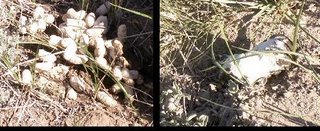 To find a Sage Grouse nest, knowing a bit of scatology is helpful. Ordinary grouse droppings look like the ones on the left, a pile of buffy pellets. The density of these pellets can give important clues to the kind of grouse behavior that has taken place in a given spot. Incubating hens undergo a metabolic change. They defecate but once a day, producing a single groaner of a scat like the one on the right. Discovering one of these means a nest is within about fifty feet. The pattern of the Sage Grouse hen's back looks precisely like the shed leaves and twigs beneath a sagebrush, so even after finding a groaner, a couple of hours of careful searching are invariably required before the nest is located. The incubating hen sits close, flushing only when practically touched.
To find a Sage Grouse nest, knowing a bit of scatology is helpful. Ordinary grouse droppings look like the ones on the left, a pile of buffy pellets. The density of these pellets can give important clues to the kind of grouse behavior that has taken place in a given spot. Incubating hens undergo a metabolic change. They defecate but once a day, producing a single groaner of a scat like the one on the right. Discovering one of these means a nest is within about fifty feet. The pattern of the Sage Grouse hen's back looks precisely like the shed leaves and twigs beneath a sagebrush, so even after finding a groaner, a couple of hours of careful searching are invariably required before the nest is located. The incubating hen sits close, flushing only when practically touched. Here a brooding hen faces the viewer. Click on the photo, and look carefully in the lower-right corner. The face of a chick, a couple of hours old, is visible. The young birds move under their mother, or away from her, depending on the ambient temperature. On a warm day like this one, even very young chicks will sit around the hen rather than underneath.
Here a brooding hen faces the viewer. Click on the photo, and look carefully in the lower-right corner. The face of a chick, a couple of hours old, is visible. The young birds move under their mother, or away from her, depending on the ambient temperature. On a warm day like this one, even very young chicks will sit around the hen rather than underneath.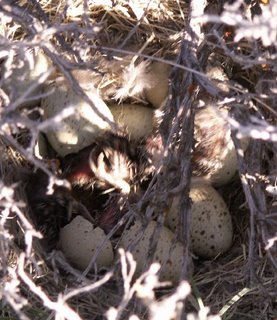 Usually six to eight spotted, khaki-colored eggs are laid in a grass-lined depression under a sagebrush. Once the last egg is laid, incubation begins, which takes just under four weeks. Last summer was unusually wet on the Anticline, so breeding success of wildlife in general was very high. Despite the fact that it hasn't yet rained this spring, bird clutch sizes are above average. Here, a clutch of nine eggs is caught in the act of hatching. Of the nine eggs, one failed to hatch, and one chick died just after hatching. Sawing an eggshell apart requires a lot of energy from a chick, and a death at this time is not unusual.
Usually six to eight spotted, khaki-colored eggs are laid in a grass-lined depression under a sagebrush. Once the last egg is laid, incubation begins, which takes just under four weeks. Last summer was unusually wet on the Anticline, so breeding success of wildlife in general was very high. Despite the fact that it hasn't yet rained this spring, bird clutch sizes are above average. Here, a clutch of nine eggs is caught in the act of hatching. Of the nine eggs, one failed to hatch, and one chick died just after hatching. Sawing an eggshell apart requires a lot of energy from a chick, and a death at this time is not unusual.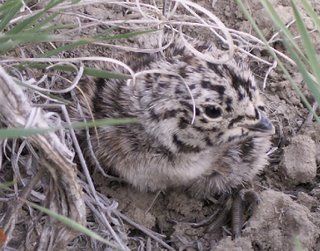 Within an hour, the chicks are dry and able to move about. They are extremely beautiful little birds, and their cryptic color pattern blends in perfectly with the dried grasses and shed sage leaves. This chick, about an hour and a half old, sits beside its mother.
Within an hour, the chicks are dry and able to move about. They are extremely beautiful little birds, and their cryptic color pattern blends in perfectly with the dried grasses and shed sage leaves. This chick, about an hour and a half old, sits beside its mother.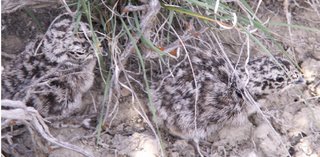 Once the chicks are five or six hours old, they have the strength to run about. The family will now leave the nest for good. As the young birds age and the weather warms, they will spend less time being brooded by the hen, who will lead them to moister areas with lots of young plant growth and small insects. As they grow up, invertebrates will make up an increasingly small portion of the omnivorous chicks' diet. By the first snow, all the birds will sustain themselves solely on sagebrush leaves (in the summer adult birds aren't at all above eating a bug or two, and I've watched them gorge themselves on Mormon Crickets [Anabrus simplex] when those insects are abundant). Of the seven chicks that left this nest, most will not survive the summer. A hen that produces two offspring that make it through to spring can be considered very successful. Once a bird is a year old, it is far less vulnerable to the ravages of nature. Aside from Golden Eagles, not many predators are capable of catching and killing one of these big, powerful and very fast-flying birds.
Once the chicks are five or six hours old, they have the strength to run about. The family will now leave the nest for good. As the young birds age and the weather warms, they will spend less time being brooded by the hen, who will lead them to moister areas with lots of young plant growth and small insects. As they grow up, invertebrates will make up an increasingly small portion of the omnivorous chicks' diet. By the first snow, all the birds will sustain themselves solely on sagebrush leaves (in the summer adult birds aren't at all above eating a bug or two, and I've watched them gorge themselves on Mormon Crickets [Anabrus simplex] when those insects are abundant). Of the seven chicks that left this nest, most will not survive the summer. A hen that produces two offspring that make it through to spring can be considered very successful. Once a bird is a year old, it is far less vulnerable to the ravages of nature. Aside from Golden Eagles, not many predators are capable of catching and killing one of these big, powerful and very fast-flying birds.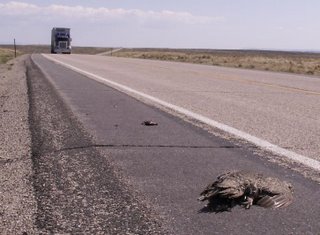 Automobiles are as big a threat to Sage Grouse as they are to any wildlife. In the summertime, hens are particularly vulnerable, as the runoff from highways produces lush little bands of tender grasses and insects on either side, luring mother birds to lead their broods to their possible demise.
Automobiles are as big a threat to Sage Grouse as they are to any wildlife. In the summertime, hens are particularly vulnerable, as the runoff from highways produces lush little bands of tender grasses and insects on either side, luring mother birds to lead their broods to their possible demise.
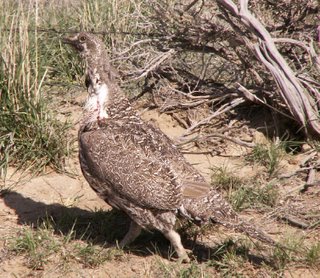 Fences pose a less obvious but far greater hazard than highways. This cock has clearly had a collision with the barbed wire fence behind him. Blood can be seen trickling freely down his neck. From here, he walked off into the sagebrush, reluctant to fly. Whether this was because he was unable to or because he chose not to out of simple soreness is hard to say. Sage Grouse are powerful fliers that often move just over the sagebrush tops at speeds as high as 70 mph. At such velocity, a single strand of wire is very hard to see, and deadly to hit. Fences that cross popular flyways take out a high number of birds. Last year Steve and I counted an average of 15 dead grouse per mile along one stretch. This represents but a portion of the birds that perish, since many of them are not killed immediately, but wander off to die elsewhere. Coyotes learn to walk the fencelines, and they drag away many grouse carcasses. Last summer, Steve and I wired beer cans that had been donated by the local bar in Farson to this stretch of high-mortality fence. This year we did not find a single dead grouse along it--a simple solution to major problem.
Fences pose a less obvious but far greater hazard than highways. This cock has clearly had a collision with the barbed wire fence behind him. Blood can be seen trickling freely down his neck. From here, he walked off into the sagebrush, reluctant to fly. Whether this was because he was unable to or because he chose not to out of simple soreness is hard to say. Sage Grouse are powerful fliers that often move just over the sagebrush tops at speeds as high as 70 mph. At such velocity, a single strand of wire is very hard to see, and deadly to hit. Fences that cross popular flyways take out a high number of birds. Last year Steve and I counted an average of 15 dead grouse per mile along one stretch. This represents but a portion of the birds that perish, since many of them are not killed immediately, but wander off to die elsewhere. Coyotes learn to walk the fencelines, and they drag away many grouse carcasses. Last summer, Steve and I wired beer cans that had been donated by the local bar in Farson to this stretch of high-mortality fence. This year we did not find a single dead grouse along it--a simple solution to major problem.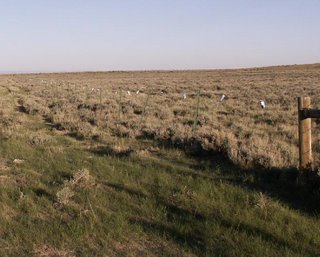 Overall, the Pinedale Anticline is very healthy. Last year's wet weather was good for the vitality of the system, and wildlife is abundant. This year's dry weather does not bode well for the short-term, and I don't expect it to be as good a summer for anything but the scavengers. Nothing abnormal here, though--this is a harsh ecosystem, full of tough residents that have dealt with worse for thousands of years. In part two we'll look at some of those other Anticline denizens.
Overall, the Pinedale Anticline is very healthy. Last year's wet weather was good for the vitality of the system, and wildlife is abundant. This year's dry weather does not bode well for the short-term, and I don't expect it to be as good a summer for anything but the scavengers. Nothing abnormal here, though--this is a harsh ecosystem, full of tough residents that have dealt with worse for thousands of years. In part two we'll look at some of those other Anticline denizens.
_____________________
All photographs in this post were taken by CPBvK on the Pinedale Anticline, May 15-17, 2006
With an average 60 frost-free days per year, spring comes late to the Anticline, but it is has most certainly arrived. This week midday temperatures soared up near 80ºF. The spectacular lekking displays of cock Sage Grouse are little more than a memory.
 May 16, 7:00am: A month ago more than 200 cocks displayed on this lek. Now, just a handful of desperate birds loiter unenthusiastically after having strutted the previous night away. Strutting hours are strictly enforced by the grouse's chief predator, the Golden Eagle (Aquila chrysaetos), which doesn't begin hunting until the sun has warmed it. When the moon is full, the grouse take full advantage of eagle-free hours, and display through the night. All of the self-respecting hens are nesting now, and only ones that have already lost their eggs will visit the leks this late, trying for a second shot. At the peak of the season, fertilization of the hens is done by a tiny minority of cocks. Whether these late lekkers represent alpha birds or some other demographic has yet to be established.
May 16, 7:00am: A month ago more than 200 cocks displayed on this lek. Now, just a handful of desperate birds loiter unenthusiastically after having strutted the previous night away. Strutting hours are strictly enforced by the grouse's chief predator, the Golden Eagle (Aquila chrysaetos), which doesn't begin hunting until the sun has warmed it. When the moon is full, the grouse take full advantage of eagle-free hours, and display through the night. All of the self-respecting hens are nesting now, and only ones that have already lost their eggs will visit the leks this late, trying for a second shot. At the peak of the season, fertilization of the hens is done by a tiny minority of cocks. Whether these late lekkers represent alpha birds or some other demographic has yet to be established. This lone hen has probably just lost her clutch of eggs. Soon she will group up with other lone females to visit what small leks are still active, then attempt a second nesting. Sage Grouse are very social birds, and they winter in huge mixed flocks. As the strutting season begins in February, the sexes segregate. Once bred, the hens beome solitary for the nesting season. Through the summer they will lead their chicks through good foraging areas, and in the fall the birds will regroup to head for the wintering grounds. Ravens (Corvus corax) are presumed to be the most important grouse egg predators, but practically nothing is known of the causes of nesting failure, since Sage Grouse nests are so incredibly hard to locate.
This lone hen has probably just lost her clutch of eggs. Soon she will group up with other lone females to visit what small leks are still active, then attempt a second nesting. Sage Grouse are very social birds, and they winter in huge mixed flocks. As the strutting season begins in February, the sexes segregate. Once bred, the hens beome solitary for the nesting season. Through the summer they will lead their chicks through good foraging areas, and in the fall the birds will regroup to head for the wintering grounds. Ravens (Corvus corax) are presumed to be the most important grouse egg predators, but practically nothing is known of the causes of nesting failure, since Sage Grouse nests are so incredibly hard to locate. To find a Sage Grouse nest, knowing a bit of scatology is helpful. Ordinary grouse droppings look like the ones on the left, a pile of buffy pellets. The density of these pellets can give important clues to the kind of grouse behavior that has taken place in a given spot. Incubating hens undergo a metabolic change. They defecate but once a day, producing a single groaner of a scat like the one on the right. Discovering one of these means a nest is within about fifty feet. The pattern of the Sage Grouse hen's back looks precisely like the shed leaves and twigs beneath a sagebrush, so even after finding a groaner, a couple of hours of careful searching are invariably required before the nest is located. The incubating hen sits close, flushing only when practically touched.
To find a Sage Grouse nest, knowing a bit of scatology is helpful. Ordinary grouse droppings look like the ones on the left, a pile of buffy pellets. The density of these pellets can give important clues to the kind of grouse behavior that has taken place in a given spot. Incubating hens undergo a metabolic change. They defecate but once a day, producing a single groaner of a scat like the one on the right. Discovering one of these means a nest is within about fifty feet. The pattern of the Sage Grouse hen's back looks precisely like the shed leaves and twigs beneath a sagebrush, so even after finding a groaner, a couple of hours of careful searching are invariably required before the nest is located. The incubating hen sits close, flushing only when practically touched. Here a brooding hen faces the viewer. Click on the photo, and look carefully in the lower-right corner. The face of a chick, a couple of hours old, is visible. The young birds move under their mother, or away from her, depending on the ambient temperature. On a warm day like this one, even very young chicks will sit around the hen rather than underneath.
Here a brooding hen faces the viewer. Click on the photo, and look carefully in the lower-right corner. The face of a chick, a couple of hours old, is visible. The young birds move under their mother, or away from her, depending on the ambient temperature. On a warm day like this one, even very young chicks will sit around the hen rather than underneath. Usually six to eight spotted, khaki-colored eggs are laid in a grass-lined depression under a sagebrush. Once the last egg is laid, incubation begins, which takes just under four weeks. Last summer was unusually wet on the Anticline, so breeding success of wildlife in general was very high. Despite the fact that it hasn't yet rained this spring, bird clutch sizes are above average. Here, a clutch of nine eggs is caught in the act of hatching. Of the nine eggs, one failed to hatch, and one chick died just after hatching. Sawing an eggshell apart requires a lot of energy from a chick, and a death at this time is not unusual.
Usually six to eight spotted, khaki-colored eggs are laid in a grass-lined depression under a sagebrush. Once the last egg is laid, incubation begins, which takes just under four weeks. Last summer was unusually wet on the Anticline, so breeding success of wildlife in general was very high. Despite the fact that it hasn't yet rained this spring, bird clutch sizes are above average. Here, a clutch of nine eggs is caught in the act of hatching. Of the nine eggs, one failed to hatch, and one chick died just after hatching. Sawing an eggshell apart requires a lot of energy from a chick, and a death at this time is not unusual. Within an hour, the chicks are dry and able to move about. They are extremely beautiful little birds, and their cryptic color pattern blends in perfectly with the dried grasses and shed sage leaves. This chick, about an hour and a half old, sits beside its mother.
Within an hour, the chicks are dry and able to move about. They are extremely beautiful little birds, and their cryptic color pattern blends in perfectly with the dried grasses and shed sage leaves. This chick, about an hour and a half old, sits beside its mother. Once the chicks are five or six hours old, they have the strength to run about. The family will now leave the nest for good. As the young birds age and the weather warms, they will spend less time being brooded by the hen, who will lead them to moister areas with lots of young plant growth and small insects. As they grow up, invertebrates will make up an increasingly small portion of the omnivorous chicks' diet. By the first snow, all the birds will sustain themselves solely on sagebrush leaves (in the summer adult birds aren't at all above eating a bug or two, and I've watched them gorge themselves on Mormon Crickets [Anabrus simplex] when those insects are abundant). Of the seven chicks that left this nest, most will not survive the summer. A hen that produces two offspring that make it through to spring can be considered very successful. Once a bird is a year old, it is far less vulnerable to the ravages of nature. Aside from Golden Eagles, not many predators are capable of catching and killing one of these big, powerful and very fast-flying birds.
Once the chicks are five or six hours old, they have the strength to run about. The family will now leave the nest for good. As the young birds age and the weather warms, they will spend less time being brooded by the hen, who will lead them to moister areas with lots of young plant growth and small insects. As they grow up, invertebrates will make up an increasingly small portion of the omnivorous chicks' diet. By the first snow, all the birds will sustain themselves solely on sagebrush leaves (in the summer adult birds aren't at all above eating a bug or two, and I've watched them gorge themselves on Mormon Crickets [Anabrus simplex] when those insects are abundant). Of the seven chicks that left this nest, most will not survive the summer. A hen that produces two offspring that make it through to spring can be considered very successful. Once a bird is a year old, it is far less vulnerable to the ravages of nature. Aside from Golden Eagles, not many predators are capable of catching and killing one of these big, powerful and very fast-flying birds. Automobiles are as big a threat to Sage Grouse as they are to any wildlife. In the summertime, hens are particularly vulnerable, as the runoff from highways produces lush little bands of tender grasses and insects on either side, luring mother birds to lead their broods to their possible demise.
Automobiles are as big a threat to Sage Grouse as they are to any wildlife. In the summertime, hens are particularly vulnerable, as the runoff from highways produces lush little bands of tender grasses and insects on either side, luring mother birds to lead their broods to their possible demise. Fences pose a less obvious but far greater hazard than highways. This cock has clearly had a collision with the barbed wire fence behind him. Blood can be seen trickling freely down his neck. From here, he walked off into the sagebrush, reluctant to fly. Whether this was because he was unable to or because he chose not to out of simple soreness is hard to say. Sage Grouse are powerful fliers that often move just over the sagebrush tops at speeds as high as 70 mph. At such velocity, a single strand of wire is very hard to see, and deadly to hit. Fences that cross popular flyways take out a high number of birds. Last year Steve and I counted an average of 15 dead grouse per mile along one stretch. This represents but a portion of the birds that perish, since many of them are not killed immediately, but wander off to die elsewhere. Coyotes learn to walk the fencelines, and they drag away many grouse carcasses. Last summer, Steve and I wired beer cans that had been donated by the local bar in Farson to this stretch of high-mortality fence. This year we did not find a single dead grouse along it--a simple solution to major problem.
Fences pose a less obvious but far greater hazard than highways. This cock has clearly had a collision with the barbed wire fence behind him. Blood can be seen trickling freely down his neck. From here, he walked off into the sagebrush, reluctant to fly. Whether this was because he was unable to or because he chose not to out of simple soreness is hard to say. Sage Grouse are powerful fliers that often move just over the sagebrush tops at speeds as high as 70 mph. At such velocity, a single strand of wire is very hard to see, and deadly to hit. Fences that cross popular flyways take out a high number of birds. Last year Steve and I counted an average of 15 dead grouse per mile along one stretch. This represents but a portion of the birds that perish, since many of them are not killed immediately, but wander off to die elsewhere. Coyotes learn to walk the fencelines, and they drag away many grouse carcasses. Last summer, Steve and I wired beer cans that had been donated by the local bar in Farson to this stretch of high-mortality fence. This year we did not find a single dead grouse along it--a simple solution to major problem. Overall, the Pinedale Anticline is very healthy. Last year's wet weather was good for the vitality of the system, and wildlife is abundant. This year's dry weather does not bode well for the short-term, and I don't expect it to be as good a summer for anything but the scavengers. Nothing abnormal here, though--this is a harsh ecosystem, full of tough residents that have dealt with worse for thousands of years. In part two we'll look at some of those other Anticline denizens.
Overall, the Pinedale Anticline is very healthy. Last year's wet weather was good for the vitality of the system, and wildlife is abundant. This year's dry weather does not bode well for the short-term, and I don't expect it to be as good a summer for anything but the scavengers. Nothing abnormal here, though--this is a harsh ecosystem, full of tough residents that have dealt with worse for thousands of years. In part two we'll look at some of those other Anticline denizens._____________________
All photographs in this post were taken by CPBvK on the Pinedale Anticline, May 15-17, 2006





3 Comments:
Carel,
Very enjoyable informative post. I especially like the simple, low-tech, solution to the deadly problem of fence wire collisions.
It is interesting about the breeding success of lekking males. You have to wonder what exactly the females see/hear/sense in the few successful males, and is it indicative of a "fitter" male (not fit in the sense of physical fitness but fit in the sense of best adapted to it's environment. I remember reading about a study of Screaming Piha's in Amazonia, birds which lek and whose primary display is its song. The study found that one bird of the many in the lek mated with about 90 percent of the females. To our ears they all sound alike, what makes his song demonstrate fitness?
Hi Clare. Yep, this lekking business is weird indeed. Whatever the females see in the succesful male is the only quality that makes him "fitter". Last year we radiotelemetried some cocks in early April, and found that they seemed to bounce around from one lek to another. Some leks consist of just a few "loser" cocks who strut for each other, since no hens or popular cocks will ever show up there. Other leks are hugely popular. It's very reminiscent of singles bars.
Carel very cool post on your Blog I am a grad student @ USU and have a similar project with sage grouse and fence collisions maybe we can swap some data ????
Ethack55@yahoo.com
Post a Comment
<< Home